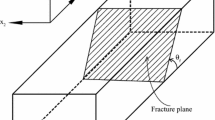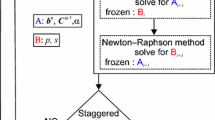Abstract
Strain distributions in specimens suitable for studying the initiation of fracture are reviewed, and distributions are developed for the steady-state propagation of cracks in plane strain lension of fully plastic materials. The functional forms of local fracture criteria are discussed for different metallurgical mechanisms. It is concluded that:
-
a)
pure Mode I (normal) fracture is unlikely to exist except in cleavage.
-
b)
there is both theoretical and experimental evidence for the development of both: sharp and flat-bottomed cracks.
-
c)
simultaneous diffuse and concentrated (Dugdale-Muskhelishvili) flow fields can occur in torsion of longitudinally grooved bars if the stress-strain curve has a maximum which causes band formation, so that a displacement criterion becomes appropriate for final fracture.
Résumé
On passe en revue les distributions de déformations dans les éprouvettes susceptibles de permettre d'étude de l'amorçage de la rupture, et l'on met l'accent sur les configurations relatives à la propagation statique de fissures amorcées dans des matériaux entièrement plastiques sollicités en ètat de déformation.
Les diverses formulations mathématiques des critères de rupture locale sont discutées en fonction de différents types de mécanismes métallurgiques. On conclut de cette étude que:
-
1°
Hormis les cas où se rencontre le clivage, une rupture de mode 1 (normale) a peu de chances de suuvenír.
-
2°
Le développement de fissures aigues et de fissures à fond plat est mis en évidence à ia fois sur le plan théorique et sur le plan expérimental.
-
3°
Dams des barres nanties d`une rainure longitudinale et soumises à torsion il peut survenir simultanément des champs découlement plastique sans frontières bien précises et de type eoncentré (Dugdale-Muskhelishvili) lorsque la courbe tension dilatation présente un maximum qui, en provoquant la formation d'une bande de glissement, rend approprié le recours à un critère de déplacement pour justifier la rupture finale.
Zusammenfassung
Es wurden Spannungsverteilung an Proben, die zum Studium für die Entstehung von Brüchen geeignet sind, nachgeprüft. Verteilungen für die Fortpflanzung der Risse im Festzustand bei planarer Anspannung und mit völlig plastischem Material, wurden entwickelt. Das funktionelle Verhalten von örtlichen Bruchmerkmalen für verschiedene metallurgische Mekanismen wurde diskutiert. Folgendes wurde festgestellt:
-
a)
es ist unwahrscheinlich, dass ein exclusiver Modus I (normal) Bruch besteht, ausser bei Teilung.
-
b)
es besteht theoretischer und experimenteller Beweis für die Entwicklung von spitzflächigen und flachbödigen Rissen.
-
c)
gleichmässig weitverbreitete und konzentrierte (Dugdale-Muskhelisvili) Flussfelder können in Drehungen von länglich gerillten Riemen vorkommen, wenn die Beanspruchungskurve ein Maximum hat, das Riemenbildung verursacht, so dass ein Verformungsmerkmal für den Endbruch zweckmässig wird.
Similar content being viewed by others
References
J.R. Rice J. Appl. Mech.34, 287–298, (1967).
A.A. Griffith Proc. First Inter. Cong. Appl. Mech. (Delft), 55–63, (1924).
E. Orowan Rpt. Prog. Phys12, 185–232, (1949).
F.A. McClintock J. Appl. Mech.35, 363–371. (1968).
C.A. Berg Proc. 4th U.S. Nat. Cong. Appl. Mech.2, 885–892, (1962).
R. Hill The Mathematical Theory of Plasticity, Oxford University Press, (1950).
W. Prager, P.G. Hodge, Jr. Theory of Perfectly Plastic Solids, John Wiley & Sons, Inc., New York, (1951).
F.A. McClintock Welding J. Res. Suppl.26, 202–208, (1961).
B.B. Hundy Metallurgia49, 109–118, (1954).
J.E. Neimark J. Appl. Mech.35, 111–116, (1968). For shoulder width, see also D J.F. Ewing and R. Hill, J. Mech. Phys Solids 15, 115–1241, (1967).
R. Hill J. of Mech. Phys Solids, 6, 236–249. See also J. of Mech. Phys Solids, 5, 302–307, (1958).
B.I. Edelson, W.M. Baldwin, Jr. Trans Quart. A.S.M.55, 230–250, (1962).
H.E. Alpaugh, Jr. ‘Investigation of the Mechanisms of Failure in the Ductile Fracture of Mild Steel’, B.S. Thesis, Dept. of Mech. Eng., M.I.T., Cambridge, (1965).
R. Hodges ‘An Experimental Study of Crack Growth Instability in Fully Plastic Tensile Specimens’, B.S. Thesis, Dept. of Mech. Eng., M.I.T., Cambridge, (1967).
A.J. Wang Quart. Appl. Math.11, 427–438, (1954).
W.N. Findley, D.C. Drucker; D.J.F. Ewing, R. Hill J. Appl. Mech.32, 493–503, (1965); J. Mech. Phys. Solids, 15, 115–124 (1967).
A. Guillen-Preckler, F.A. McClintock, R.D. White Proc. IstInt. Conf. Fracture, Sendai1, 411–427, (1966).
P.W. Bridgman ‘Studies in Large Plastic Flow and Fracture’, McGraw Hill, New York, (1952).
D.P. Clausing ‘The Tensile Fracture of Mild Steel’, PhD. Thesis, Calif. Inst. of Tech., Pasadena, (1966).
K.C. Norris ‘Strain in the Neck of a Tensile Specimen’, M.S. Thesis, M.I.T., Dept. of Mech. Eng., Cambridge, (1967).
F.A. McClintock Materials Res, and Standards, 1, 277–279, (1961).
A.R. Rosenfield, P.K. Dai, G.T. Hahn Proc. First Int. Conf. on Fracture, Sendai1, 223–258, (1966).
J.L. Swedlow, M.L. Williams, W.H. Yang Proc. 1st lnt. Conf. Fracture, Sendai1, 259–282, (1966).
D.A. Bateman, F.J. Bradshaw, D.P. Rooke ‘Some Observations on Surface Deformation Round Cracks in Stressed Sheets’, R.A.E. Tech. Note CPM 63, Ministry of Aviation, London W.C., 2, (1964).
J.B. Walsh, A.C. Mackenzie J. Mech. Phys Solids1, 247–257, (1959).
I. Kayan ‘Crack Initiation and Crack Growth Process on Rectangular Cross Sectional and Longitudinally Notched Bars Under Plastic Torsion’, Research Memo 17, Fatigue and Plasticity Lab., M.I.T., Dept. of Mech. Eng., (See also: R.D. Landis, 1962, ‘Crack Initiation in Rectangular Longitudinally Grooved Specimens Under Plastic Torsion II’, Research Memo 37, Fatigue and Plasticity Lab., M.I.T., Dept. of Mech. Eng., Cambridge, (1959)).
F.A. McClintock, W.R. O'Day, Jr. Proc. Ist lnt. Conf. Fracture, Sendai1, 75–98, (1965).
C.P. Sullivan Welding Research Council Bulletin 122, New York, (1967).
J.J. Gilman J. Metals6, 621–629, (1954).
A.N. Stroh, Phil. Mag.3, 597–606, (1958).
A. Deruyttere, G.B. Greenough J. Inst. Met.84, 337–345, (1956).
T.L. Johnston, R.J. Stokes, C.H. Li Phil. Mag.7, 23–24, (1962).
D. Hull Acta Met.8, 11–18, (1960).
A.H. Cottrell Fracture, B.L. Averbach et al., eds., Wiley, New York, 20–53, (1959).
R.J. Brinkerhoff ‘Elastic-Plastic Strain Fields for a Cylindrical Inclusion in Shear’, M.S. Thesis, Dept. of Mech. Eng., M.I.T., Cambridge, (1966). See also (41).
A. Kelly, G.J. Davies Metallurgical Reviews10, 1–78, (1965).
I.G. Palmer, G.C. Smith 2nd Bolton Landing Conf. on Oxide Dispersion Strengthening, Lake George, New York (1966).
V.A. Tipnis, N.H. Cook J. Basic Eng. Trans ASME89D, 533–540, (1967).
J.F. Knott, A.H. Cottrell J. Iron and Steel Inst.201, 249–260, (1963).
F.A. McClintock, S.M. Kaplan, C.A. Berg, Jr. Int. J. Fracture Mech.2, 614–627, (1966).
F.A. McClintock ‘On the Mechanics of Fracture from Inclusions’, ASM Seminar on Ductility, Cleveland Ohio, (1967).
P.J.E. Forsyth, C.A. Stubbington, R.N. Wilson ‘The Growth of Free Slip Paths as a Primary Cause of Fatigue in Metals’, RAE Tech. Note Met-Phys. 333, Ministry of Aviation, London W.C. 2, (1961).
F.A. McClintockDiscussion in Fatigue in Aircraft Structures A.M. Freudenthal, Ed., Academic Press, New York, 78–79, (1956).
F.A. McClintock, A.S. Argon, editors Mechanical Behavior of Materials, Addison Wesley, Reading, Mass., 522, (1966).
F.A. McClintockProc. Int. Conf. Fatigue of Metals, Inst. Mech. Eng., 538–542,(1956).
H.C. Rogers, Trans. Met. Soc. AIME218, 498–506, (1960).
A.P. Green J. Mech. Phys. Solids2, 197–211, (1954).
J.I. Bluhm, R.J. Morrissey Proc. 1st Int Conf. Fracture, Sendai3, 1739–1780, (1966).
A. Kelly, W.R. Tyson, A.H. Cottrell Phil. Mag.15, 567–586, (1967).
H. Suzuki Proc. 1st lnt. Conf. Fracture, Sendai2, 613–614, (1966).
F.A. McClintock Proc. Roy. Soc. A285, 58–72, (1965).
F.A. McClintock ‘Crack Growth in Fully Plastic Grooved Tensile Specimens’, Research Memo 105, Fatigue and Plasticity Lab., M.I.T., Dept. of Mech. Eng., Cambridge, (1966); Physics of Strength and Plasticity, MIT Press, (1969).
M.F. Henry ‘An Investigation of Fine Cracks in Ductile Fracture, M.S. Thesis, Dept. of Mech. Eng., M.I.T., Cambridge, (1966).
Author information
Authors and Affiliations
Rights and permissions
About this article
Cite this article
McClintock, F.A. Local criteria for ductile fracture. Int J Fract 4, 101–130 (1968). https://doi.org/10.1007/BF00188939
Received:
Issue Date:
DOI: https://doi.org/10.1007/BF00188939




